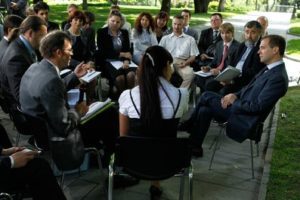
Petr Sharov, Blacksmith’s Russia and Central Asia coordinator, attended a meeting with President Dmitry Medvedev at the Kremlin in Moscow on June 8, along with representatives from 24 other NGOs working in Russia.
At the informal meeting, which took place on the Kremlin’s green lawn, Medvedev told the gathering of NGOs that Russia was ready to deal with the large scale, mostly inherited environmental disaster facing them – more than 30 billion tonnes of accumulated hazardous waste, with over half the population in 40 regions living in highly polluted conditions.
While this is good news, there is also cause for worry, as Petr reports from Moscow:
This was actually the first ever official meeting between the Russian President and environmental NGOs, which could be a sign of increased attention of Russia’s top authorities to environmental issues. In addition to Blacksmith, the list of 25 NGOs included Greenpeace, World Wildlife Fund, as well as several smaller regional groups and even a few government created “eco-movements”.
A broad range of issues was discussed, from saving Lake Baikal and cutting forests to eco-education for children and attacks on environmental activists. The NGOs pointed out the obvious: current weak government environmental policies and lack of enforcement of environmental legislation in the country.
After meeting with the NGOs, Medvedev met with the State Council the next day in Dzerzhinsk – identified by Blacksmith as one of the top ten most polluted places in the world – to discuss the same environmental agenda. At both meetings, the issue of pollution was one of the key themes.
The positive:
The President was thoughtful about the problems we raised. We saw that he was trying to understand the issues. From the start he has positioned himself as the “green” President.
A year ago, Medvedev declared an ambitious government strategy to deal with environmental issues and improve the situation in the country. It was the first such strategy ever to appear in the last 15 years. Now it’s time to see if it actually works.
It is obvious that the President’s administration has the idea that something needs to be done about the industrial pollution accumulated since the Soviet Union that is still building up. They acknowledge that millions live with pollution. The Minister of Natural Resources and Environment reported that they had identified 194 hotspots that would be worked on under a special federal cleanup program. Moreover, they announced the launch of three cleanup projects with $6 billion RUB in funding (about US$200 million).
The negative:
While their intentions are good, they do not seem to see a relation between the health of people and the contamination.
For example, the three projects they announced are all targeted at areas where no one really lives! Meanwhile in Dzerzhinsk, a hotspot with a population of 300,000, where the meeting was held, the cleanup is being just planned in some unknown future. I am afraid if they continue with their plan, there will be little change in terms of the number of people at risk from pollution.
As a matter of fact in Russia right now, there is very little experience of doing pollution cleanup and no system for monitoring the impacts of pollution on people’s health. This is a problem. At the meeting, I handed the President a report on our project in the Rudnaya River Valley, where in three years, we managed to reduce blood lead concentrations of children two times. Our project is the ONLY example of heavy metals cleanup and simultaneous health intervention in Russia. They must use our experience and focus on cleaning up the most contaminated places with the most people first. This is the idea we brought to the attention of the President and it has yet to be realized by the government.





